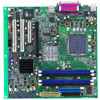Asus P5MT-C User Manual - Page 17
Gigabit LAN solution, Serial ATA II technology, Built-in SATA RAID solution, USB 2.0 technology,
 |
View all Asus P5MT-C manuals
Add to My Manuals
Save this manual to your list of manuals |
Page 17 highlights
Gigabit LAN solution The motherboard comes with dual Gigabit LAN controllers and ports to provide a total solution for your networking needs. The onboard Broadcom® BCM5753 Gigabit LAN controllers use the PCI Express interface and could achieve network throughput close to Gigabit bandwidth. See page 2-23 for details. Serial ATA II technology The motherboard supports the Serial ATA II technology through the Serial ATA interfaces controlled by the Intel® ICH7R. The SATA specification allows for thinner, more flexible cables with lower pin count, reduced voltage requirement, and up to 300 MB/s data transfer rate. Built-in SATA RAID solution The Intel® ICH7R allows RAID 0, RAID 1, RAID 0+1, and software RAID 5 configuration for SATA hard disk drives via the Intel® Matrix Storage Manager or the LSI Logic Embedded SATA RAID Setup Utility (no RAID 5). See page 2-25 and Chapter 5 for details. USB 2.0 technology The motherboard implements the Universal Serial Bus (USB) 2.0 specification, dramatically increasing the connection speed from the 12 Mbps bandwidth on USB 1.1 to a fast 480 Mbps on USB 2.0. USB 2.0 is backward compatible with USB 1.1. See pages 2-23 and 2-26 for details. Temperature, fan, and voltage monitoring The CPU temperature is monitored by the ASIC (integrated in the Winbond hardware monitor) to prevent overheating and damage. The system fan rotations per minute (RPM) is monitored for timely failure detection. The ASIC monitors the voltage levels to ensure stable supply of current for critical components. See page 4-29 for details. ASUS P5MT-C 1-3















